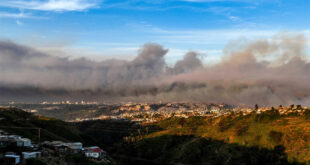After four straight years of low flows the Mekong River recorded record water levels in the first four months of 2022.
According to Mekong River Commission (MRC), from November 2021 to April 2022 the Lower Mekong River Basin (LMB) was wetter than normal years with rainfall 25 percent above average basin-wide.
At Thailand’s Chiang Saen, the second uppermost monitoring station in the LMB, the level rose from 1.84 meters on Mar. 2 to 3.25 meters on May 11.
The latter figure is lower than the 60-year average until 2021, but notably higher than during the drought years of 2019–21.
At the Vientiane station in the Laotian capital, water levels even exceeded the 60-year average.
In Cambodia, levels along the stretch from the Stung Treng to Kompong Cham monitoring stations rose by 0.66-2.22 meters, an increase of around 1.5 meters from last year, the MRC said in a statement.
The Vietnam National Center for Hydro-Meteorological Forecasting (NCHMF) said late last month that the Mekong Delta, where the river reaches the sea, in April received 15-20 percent more water than average.
In May and June the levels are expected to be 20-30 percent higher than last year, the center said.
The MRC said the higher water levels were the result of not only increased rainfall but also China releasing more water from its upstream dams.
But the MRC warned that with China releasing water now the LMB could face shortages from July.
Nguyen Huu Thien, an independent consultant based in Can Tho City in the delta, last month also said China releasing dam water during the dry season means during the annual flood season in the Mekong Delta from July to September there would be little or even no flooding.
For generations, the LMB region has been depending on the annual floods to inundate fields to sow seeds.
Usually it start ins late July or early August and goes on until November or even later, blessing the region with extraordinary fertility by bringing silt from upstream areas.
However, in recent years upstream dams and climate change have altered the routine.
According to foreign and Vietnamese experts, the dams reduce the sediments and fish that are supposed to move downstream during the flood season.
The Mekong has suffered three years of extremely low flows and droughts during the wet season, causing fisheries and agricultural productivity to suffer greatly.
Low flows and droughts are mostly caused by a lack of rainfall, but upstream dams also contribute to wet season droughts by storing significant amounts of water, Brian Eyler, Southeast Asia program director and Mekong Dam Monitor Co-Lead, Stimson Center, said at a virtual event February.
He said China has built 129 dams along the river. Most of the Mekong’s waters, as much as 56 percent, is stored in China.
According to MRC figures, water levels across the basin remain well below the 60-year average recorded from 1961 to 2021 as well as the most recent 10-year period of healthy water flow from 2008 to 2017.
MRC Secretariat CEO Anoulak Kittikhoun warned last month in his first ‘State of the Mekong Address’ that climate change, drought and water infrastructure projects have created an “unprecedented challenge” for Southeast Asia.
“Our wetlands are disappearing, nourishing sediment is reduced and rising salinity is spoiling rice crops.”
Last year the traditional wet season was shortened from five months to four from July to October with little rain in June.
“That’s what makes the replenishment of water so important,” the MRC said.
- Reduce Hair Loss with PURA D’OR Gold Label Shampoo
- Castor Oil Has Made a “Huge” Difference With Hair and Brow Growth
- Excessive hair loss in men: Signs of illness that cannot be subjective
- Dịch Vụ SEO Website ở Los Angeles, CA: đưa trang web doanh nghiệp bạn lên top Google
- Nails Salon Sierra Madre
 VnExpress News The News Gateway of Vietnam
VnExpress News The News Gateway of Vietnam




